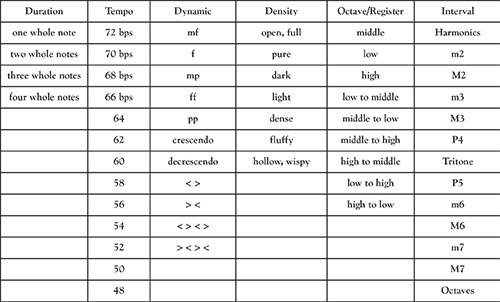Question: I only have an hour a day to practice. How I can I best use the time?
Answer: When planning for sixty minutes of practice on the flute, keep it simple. Relax, unwind, let go of stress and be thankful for the one hour of practice time. Great things can be accomplished in an hour if you plan carefully. Try this SIMPLE acronym.
S: Simplify
Set your mind, schedule your 60 minutes and then divide your hour into 15-minute blocks of time devoted to sound, technique, performing and playing.
I: Intention
For the first 15 minutes, focus on sound production. The goal is to sustains tones in each octave, at various tempos, with different dynamics, and with a range of colors. If the sound on one note is warm, rich, resonant and inviting, that is terrific because that quality can be transferred to another note. Make a practice notebook noting your good notes and those that need improvement. Use the chart below to help you systematically vary duration, dynamics, density, and dimension of sound.
Fifteen minutes of sound production should be followed by fifteen minutes of technical practice that should include:
M: Make Music
Make music when you practice your technique. Technical practice should include scales (chromatic, diatonic major and minor, whole tone, octatonic and pentatonic, etc.) with musicality in mind. Chords (triads, sevenths, etc.) should sound harmonically precise, with minute adjustments for major chords versus minor chords and diminished chords versus augmented chords. Whether you concentrate on one scale for fifteen minutes or many scales, make your technique facile, free of tension, and flawless in fingering. Vary articulation between all slurred, all tongued, and combinations of slurred and tongued notes. The fifteen minutes of technique will fly by because you are enjoying making music with your scales.
P: Practice
Practice does not make perfect; practice makes permanent. For the next fifteen minutes practice your performance. How you use this time will determine how you perform.
Is there a technical passage in your solo piece that needs improvement? Practice just those measures with a specific goal in mind such as easing tension, correcting fingering mistakes, playing rhythmically, or perhaps playing slower or faster. Then ask yourself whether you solved the technical problem. You will either know whether you have done it, or you will realize you are not really listening or paying attention. If you have trouble listening and paying attention, practice in shorter segments with strong focus. With practice you can lengthen these segments and build your concentration skills.
L: Learn
Learn from your mistakes; learn from your elders; and learn by doing. You have heard it all. Nevertheless, it is worth repeating again and again – learn and keep learning. In your last fifteen minutes of practice, learn something new and play for your heart and soul. It is not worth practicing if you are not enjoying playing. By renewing the playing part at the end of every practice session you will feel fulfilled. In essence, my advice is to play your etudes, play your studies, play your solos, play your excerpts – play so that you will know what to work on tomorrow. It is the playing that tests our performance; it is the playing that gives us our motivation; and it is the playing that we wish to keep alive.
E: Easy
Julius Baker often said, “If you never make a mistake, you never make a mistake!” In his own practice, he played slowly and carefully before speeding things up.
Try the SIMPLE acronym with your practicing. With just an hour, these simple intentions will help your practice session become more productive and easy.

Send your questions to Ask the Pro at editor@flutetalkmagazine.com






